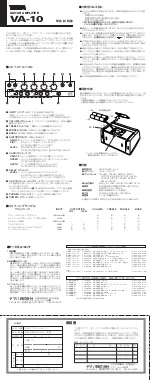
Page 4
VsL Series Power Amplifiers
Models VsL460, VsL900, VsL1500
Operation
Connecting Power / Circuit Size Requirements.
VsL Series amplifier power requirements are rated at “idle”, 1/8th power
(“typical” music conditions), 1/3rd power (“continuous” music conditions),
and maximum rated power. The maximum power current draw rating is limit-
ed only by the front panel circuit breaker. Consult the specifications at the end
of this manual for the “typical” current that each amplifier will demand. Mains
voltage must also be correct and the same as that printed on the rear of the
amplifier. Damage caused by connecting the amplifier to improper AC voltage
is not covered by any warranty. Note: Always turn off and disconnect the
amplifier from mains voltage before making audio connections, and as an
extra precaution, have the attenuators turned down during power-up.
Cooling Requirements.
VsL Series amplifiers use a forced-air cooling system to maintain a low, even
operating temperature. Drawn by a two-speed fan mounted behind the front
panel, air enters through the front grill and courses through the cooling fins of
the heat sink, which dissipates power transistor heat, before exiting through the
side panel ports. Make sure that there is enough space around the front of the
amplifier to allow air to enter, and around the sides of the amp to allow the
heated air to exit. If the amp is rack-mounted, do not use doors or covers on
the front of the rack; the exhaust air must flow without resistance. Note:
Whatever type of rack you are using, make sure that the heated air can escape
freely, and that there is no resistance to the intake of cool air through the front
grill.
Mode Selection.
The push-button Mode Select switch (located on the rear panel between input
connections for Channels A and B) configures the amplifier for either Stereo
Mode or Bridged Mono Mode. Amplifiers are factory-configured for Stereo
Mode. To bridge the amplifier, turn it off, and push the mode selection switch
to the “bridge” position. Signal is applied to Channel A’s input only. Both
attenuators are used to control signal level; in addition, both must be set at the
same setting. See the drawings on pages 6 & 7 for essential connection infor-
mation.
Stereo Mode.
(Drawing 1) In Stereo Mode, both channels operate independently, with their
input attenuators controlling their respective levels. Signal at Channel A’s
input produces output at Channel A’s output, while signal at Channel B’s input
produces output at Channel B’s output. Recommended minimum nominal load
impedance for stereo operation is 2 ohms per channel. Either the 1/4" (TRS)
inputs or the barrier strip inputs may be used. Loudspeakers are connected to
the red and black 5-way output binding posts for each channel.
Bridged Mono Mode.
(Drawing 2) Bridged Mono Mode straps both amplifier channels together to
make a very powerful single channel monaural amplifier. One channel “push-
es” and the other “pulls” equally, doubling the power over that of either chan-
nel alone. Signal is applied to Channel A’s input only. In the bridged mode,
both attenuators are used to control signal level; in addition, both must be set at
the same setting. Either the 1/4" (TRS) input or the barrier strip input may be
used. Speakers are connected across the red “hot” (+) terminals: connect A’s
terminal to the positive (+) speaker wire, and connect B’s terminal to the nega-
tive (-) speaker wire.
Note: Use extreme caution when operating the amplifier in bridged mode.
Never ground either side of the speaker cable when the amplifier is in bridged
mode; both sides are “hot.” If an output patch panel is used, all connections
must be isolated from each other and from the panel. The recommended mini-
mum nominal load impedance in the bridged mode is 4 ohms, which is the
equivalent to driving both channels at 2 ohms. Driving bridged loads of less
than the recommended minimums will activate the IGM circuitry, resulting in
a loss of power, and may also cause a thermal protect condition.
Sending One Signal to Both Channels.
(Drawing 3) To send the same signal to both channels, connect the input signal
to Channel A via the TRS input connector or the Input Barrier Strip. Run
jumpers from the positive and negative connectors of Channel A’s Input
Barrier Strip to those of Channel B’s. Both channels share the input signal, but
will operate independently. Speakers are connected as in Stereo Mode. Note:
Regardless of operating mode, NEVER connect amplifier outputs together!
Connecting Outputs.
Speakers are connected using 5-way Output Binding Post connectors. For
more information, see the sections on Stereo & Bridged Mono mode and
Drawings 1-3.
Connecting Inputs.
Both the barrier strip and 1/4-inch TRS input connectors accept balanced and
unbalanced audio connections. Note: When using three-pole (‘stereo’) TRS
connectors to connect unbalanced signals, make sure that the ring (negative)
connection is made either to the cold (-) output of the source equipment, or to
ground. Unbalanced, two-pole connectors may be used without modification.
In Stereo Mode, one or both channels may be used. In the Bridged Mono
Mode, both outputs are driven from Channel A’s input; Channel B’s input is
unused. Diagrams showing input connections can be found on pages 9 & 10.






























